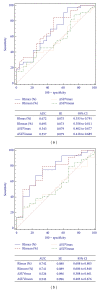Prospective analysis of 18F-FDG PET/CT predictive value in patients with low rectal cancer treated with neoadjuvant chemoradiotherapy and conservative surgery
- PMID: 24877151
- PMCID: PMC4024401
- DOI: 10.1155/2014/952843
Prospective analysis of 18F-FDG PET/CT predictive value in patients with low rectal cancer treated with neoadjuvant chemoradiotherapy and conservative surgery
Abstract
This study prospectively assessed (18)F-FDG PET/CT in predicting the response of locally advanced low rectal cancer (LRC) to neoadjuvant chemoradiation (nCRT).
Methods: 56 patients treated with chemoradiation underwent two (18)F-FDG PET/CT scans (baseline and 5-6 weeks post-nCRT). (18)F-FDG uptake (SUVmax and SUVmean) and differences between baseline (SUV1) and post-nCRT (SUV2) scans (ΔSUV and RI%) were evaluated. Results were related to the Mandard's TRG and (y)pTNM.
Results: (18)F-FDG PET/CT sensitivity, specificity, accuracy, PPV and NPV resulted in 88.6%, 66.7%, 83.92%, 90.7%, and 61.5%. SUV2 resulted in better than SUV1 to predict nCRT response by TRG, with no significant statistical difference between the SUVmax2 and SUVmean2 AUC (0.737 versus 0.736; P = 0.928). The same applies to the (y)pTNM (0.798 versus 0.782; P = 0.192). In relation to the TRG, RI values had a higher AUC than ΔSUV, with no significant difference between RImax and RImean (0.672 versus 0.695; P = 0.292). The same applied to the (y)pTNM (0.742 versus 0.741; P = 0.940). In both cases ΔSUV does not appear to be a good predictive tool. Logistic regression confirmed the better predictive role of SUVmax2 for the (y)pTNM (odds ratio = 1.58) and SUVmean2 for the TRG (odds ratio = 1.87).
Conclusions: (18)F-FDG PET/CT can evaluate response to nCRT in LRC, even if more studies are required to define the most significant parameter for predicting pathologic tumor changes.
Figures




Similar articles
-
Comparison of (18)F-FDG PET/CT methods of analysis for predicting response to neoadjuvant chemoradiation therapy in patients with locally advanced low rectal cancer.Abdom Imaging. 2015 Jun;40(5):1190-202. doi: 10.1007/s00261-014-0277-8. Abdom Imaging. 2015. PMID: 25348731
-
Prediction of tumor response after neoadjuvant chemoradiotherapy in rectal cancer using (18)fluorine-2-deoxy-D-glucose positron emission tomography-computed tomography and serum carcinoembryonic antigen: a prospective study.Abdom Radiol (NY). 2016 Aug;41(8):1448-55. doi: 10.1007/s00261-016-0698-7. Abdom Radiol (NY). 2016. PMID: 27116012
-
Predictive value of 18F-FDG PET/CT on survival in locally advanced rectal cancer after neoadjuvant chemoradiation.Eur Rev Med Pharmacol Sci. 2018 Dec;22(23):8227-8236. doi: 10.26355/eurrev_201812_16517. Eur Rev Med Pharmacol Sci. 2018. PMID: 30556862
-
Sequential FDG-PET/CT reliably predicts response of locally advanced rectal cancer to neo-adjuvant chemo-radiation therapy.Eur J Nucl Med Mol Imaging. 2007 Oct;34(10):1583-93. doi: 10.1007/s00259-007-0426-1. Epub 2007 May 15. Eur J Nucl Med Mol Imaging. 2007. PMID: 17503039 Clinical Trial.
-
18F-FDG-PET evaluation of treatment response to neo-adjuvant therapy in patients with locally advanced rectal cancer: a meta-analysis.Int J Cancer. 2012 Dec 1;131(11):2604-11. doi: 10.1002/ijc.27557. Epub 2012 Jun 28. Int J Cancer. 2012. PMID: 22447461 Review.
Cited by
-
MRI VS. FDG-PET for diagnosis of response to neoadjuvant therapy in patients with locally advanced rectal cancer.Front Oncol. 2023 Jan 18;13:1031581. doi: 10.3389/fonc.2023.1031581. eCollection 2023. Front Oncol. 2023. PMID: 36741013 Free PMC article. Review.
-
Magnetic Resonance Imaging Evaluation in Neoadjuvant Therapy of Locally Advanced Rectal Cancer: A Systematic Review.Radiol Oncol. 2017 Aug 16;51(3):252-262. doi: 10.1515/raon-2017-0032. eCollection 2017 Sep. Radiol Oncol. 2017. PMID: 28959161 Free PMC article.
-
Evaluation of pre-treatment F-18 FDG PET/CT according to Mandard classification in locally advanced rectal cancer patients undergoing neoadjuvant chemoradiotherapy.BMC Cancer. 2025 Aug 4;25(1):1262. doi: 10.1186/s12885-025-14659-y. BMC Cancer. 2025. PMID: 40760425 Free PMC article.
-
Role of 18F-PET-CT to predict pathological response after neoadjuvant treatment of rectal cancer.Discov Oncol. 2021 May 18;12(1):16. doi: 10.1007/s12672-021-00405-w. Discov Oncol. 2021. PMID: 35201442 Free PMC article.
-
Standardized Index of Shape (DCE-MRI) and Standardized Uptake Value (PET/CT): Two quantitative approaches to discriminate chemo-radiotherapy locally advanced rectal cancer responders under a functional profile.Oncotarget. 2017 Jan 31;8(5):8143-8153. doi: 10.18632/oncotarget.14106. Oncotarget. 2017. PMID: 28042958 Free PMC article.
References
-
- Grassetto G, Marzola MC, Minicozzi A, Al-Nahhas A, Rubello D. F-18 FDG PET/CT in rectal carcinoma: where are we now? Clinical Nuclear Medicine. 2011;36(10):884–888. - PubMed
-
- National Comprehensive Cancer Network Clinical Practice Guidelines in Oncology: Rectal Cancer, Version 2. 2010, http://www.nccn.org/ - PubMed
-
- Capirci C, Rampin L, Erba PA, et al. Sequential FDG-PET/CT reliably predicts response of locally advanced rectal cancer to neo-adjuvant chemo-radiation therapy. European Journal of Nuclear Medicine and Molecular Imaging. 2007;34(10):1583–1593. - PubMed
-
- Gearhart SL, Frassica D, Rosen R, Choti M, Schulick R, Wahl R. Improved staging with pretreatment positron emission tomography/computed tomography in low rectal cancer. Annals of Surgical Oncology. 2006;13(3):397–404. - PubMed
-
- Kapiteijn E, Marijnen CA, Nagtegaal ID, et al. Preoperative radiotherapy combined with total mesorectal excision for resectable rectal cancer. New England Journal of Medicine. 2001;345(9):638–646. - PubMed
Publication types
MeSH terms
Substances
LinkOut - more resources
Full Text Sources
Other Literature Sources
Medical

